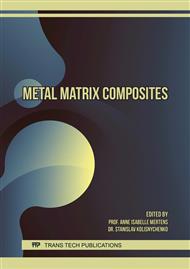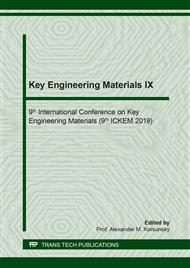[1]
M. Haghshenas, Metal–Matrix Composites,, in Reference Module in Materials Science and Materials Engineering, Elsevier, (2016).
DOI: 10.1016/b978-0-12-803581-8.03950-3
Google Scholar
[2]
J. Nafar Dastgerdi, B. Anbarlooie, A. Miettinen, H. Hosseini-Toudeshky, and H. Remes, Effects of particle clustering on the plastic deformation and damage initiation of particulate reinforced composite utilizing X-ray CT data and finite element modeling,, Composites Part B: Engineering, vol. 153, p.57–69, Nov. (2018).
DOI: 10.1016/j.compositesb.2018.07.027
Google Scholar
[3]
MSC Software, Digimat User Manual Documentation., MSC software company, (2014).
Google Scholar
[4]
J. Kim, homogenization and uncertainty analysis for fiber reinforced composites,, p.108.
Google Scholar
[5]
H. Liu, D. Zeng, Y. Li, and L. Jiang, Development of RVE-embedded solid elements model for predicting effective elastic constants of discontinuous fiber reinforced composites,, Mechanics of Materials, vol. 93, p.109–123, Feb. (2016).
DOI: 10.1016/j.mechmat.2015.10.011
Google Scholar
[6]
N. K. Sharma, R. K. Misra, and S. Sharma, Finite element modeling of effective thermomechanical properties of Al–B4C metal matrix composites,, Journal of Materials Science, vol. 52, no. 3, p.1416–1431, Feb. (2017).
DOI: 10.1007/s10853-016-0435-1
Google Scholar
[7]
J. J. Williams, J. Segurado, J. LLorca, and N. Chawla, Three dimensional (3D) microstructure-based modeling of interfacial decohesion in particle reinforced metal matrix composites,, Materials Science and Engineering: A, vol. 557, p.113–118, Nov. (2012).
DOI: 10.1016/j.msea.2012.05.108
Google Scholar
[8]
N. Chawla, R. Sidhu, and V. Ganesh, Three-dimensional visualization and microstructure-based modeling of deformation in particle-reinforced composites,, Acta Materialia, vol. 54, no. 6, p.1541–1548, Apr. (2006).
DOI: 10.1016/j.actamat.2005.11.027
Google Scholar
[9]
J. F. Zhang, X. X. Zhang, Q. Z. Wang, B. L. Xiao, and Z. Y. Ma, Simulations of deformation and damage processes of SiCp/Al composites during tension,, Journal of Materials Science & Technology, vol. 34, no. 4, p.627–634, Apr. (2018).
DOI: 10.1016/j.jmst.2017.09.005
Google Scholar
[10]
H. Ji, R. Mclendon, J. A. Hurtado, V. Oancea, and J. Bi, Multi-scale Material Modeling with the Mean-Field Homogenization Method,, p.26, (2018).
Google Scholar
[11]
J. Zhang et al., 3D Microstructure-based finite element modeling of deformation and fracture of SiCp/Al composites,, Composites Science and Technology, vol. 123, p.1–9, Feb. (2016).
DOI: 10.1016/j.compscitech.2015.11.014
Google Scholar
[12]
Z. Yuan, F. Li, F. Xue, M. He, and M. Z. Hussain, Analysis of the stress states and interface damage in a particle reinforced composite based on a micromodel using cohesive elements,, Materials Science and Engineering: A, vol. 589, p.288–302, Jan. (2014).
DOI: 10.1016/j.msea.2013.09.097
Google Scholar
[13]
L. Zhang et al., Aluminum/graphene composites with enhanced heat-dissipation properties by in-situ reduction of graphene oxide on aluminum particles,, Journal of Alloys and Compounds, vol. 748, p.854–860, Jun. (2018).
DOI: 10.1016/j.jallcom.2018.03.237
Google Scholar
[14]
W.-G. Jiang, R.-Z. Zhong, Q. Qin, and Y.-G. Tong, Homogenized Finite Element Analysis on Effective Elastoplastic Mechanical Behaviors of Composite with Imperfect Interfaces,, International Journal of Molecular Sciences, vol. 15, no. 12, p.23389–23407, Dec. (2014).
DOI: 10.3390/ijms151223389
Google Scholar
[15]
A. J. C. Wilson, The thermal expansion of aluminium from 0 to 650 C,, Proceedings of the Physical Society, vol. 53, no. 3, p.235–244, May (1941).
Google Scholar
[16]
J. S. Bunch, Mechanical and electrical properties of graphene sheets., Cornell University, (2008).
Google Scholar



